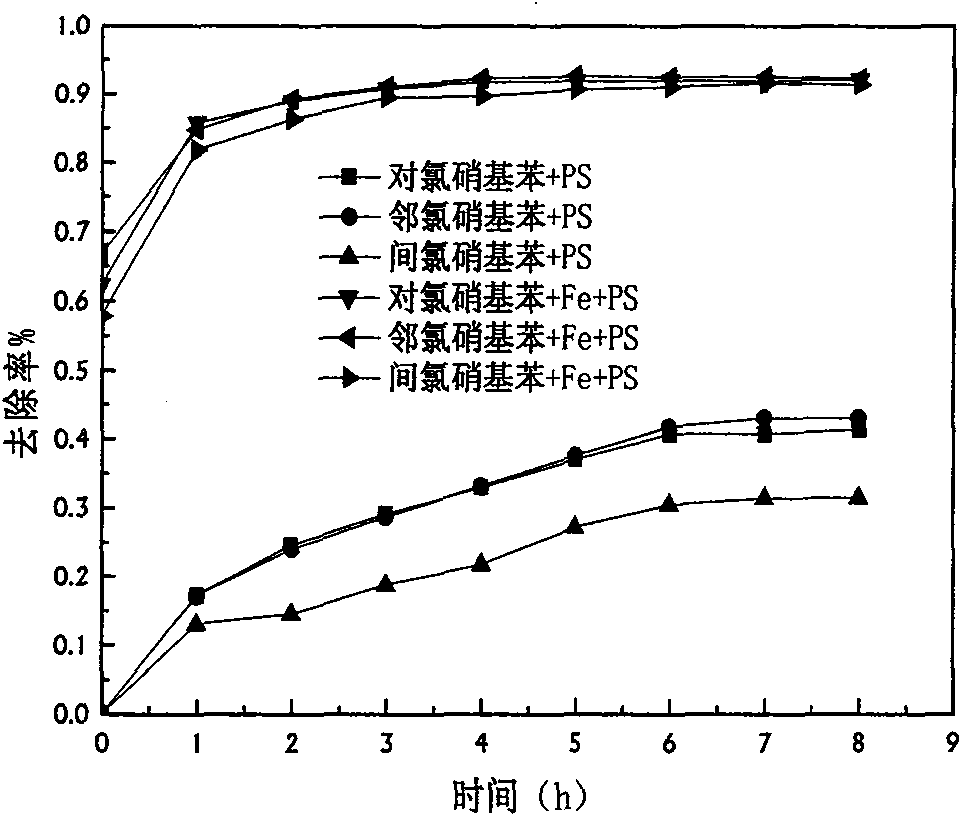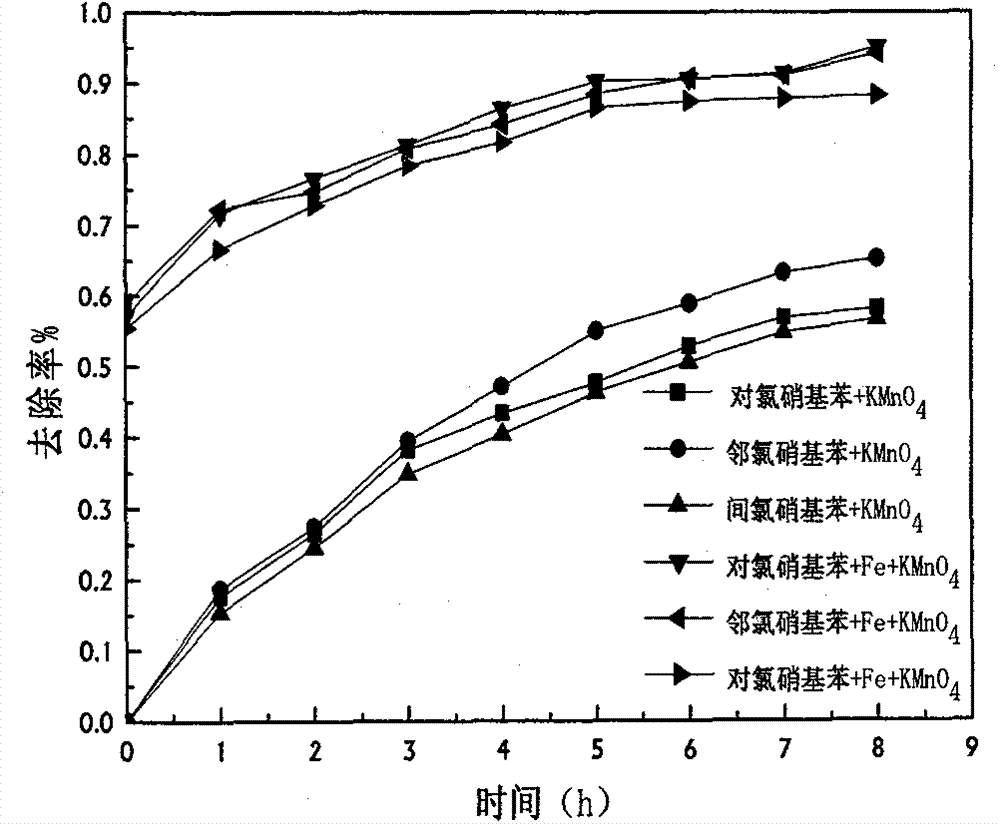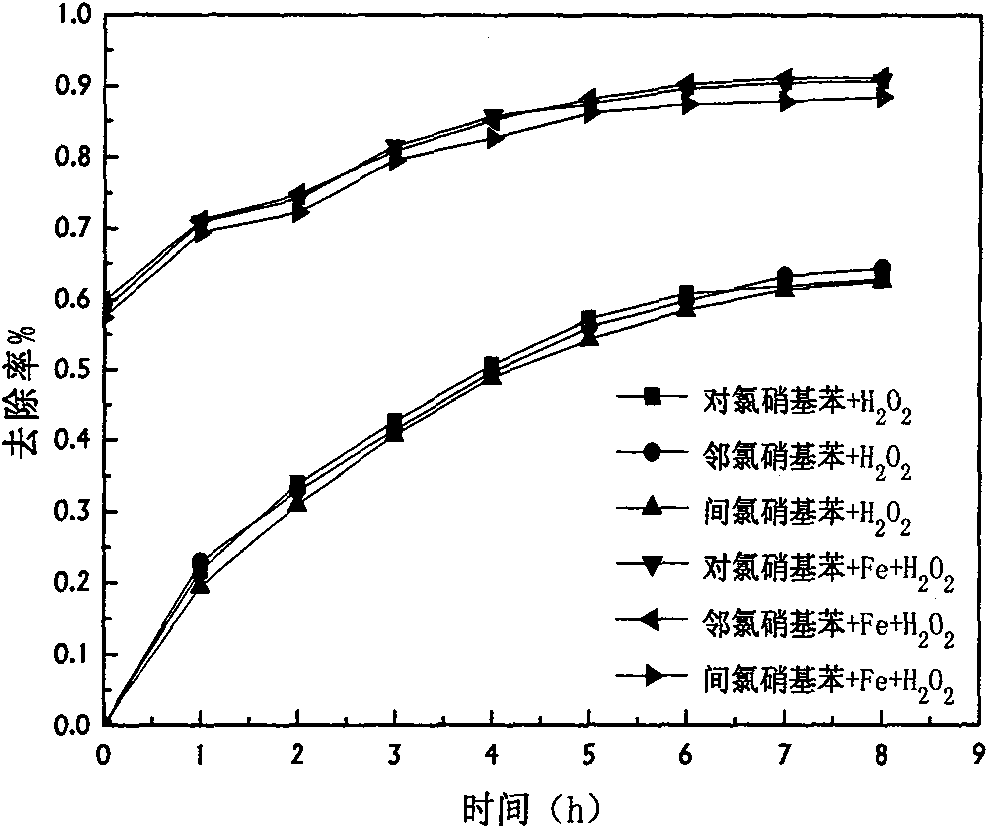Method for increasing speed of oxidative degradation of organic pollutant in soil
A technology for organic pollutants, oxidative degradation
- Summary
- Abstract
- Description
- Claims
- Application Information
AI Technical Summary
Problems solved by technology
Method used
Image
Examples
Embodiment 1
[0041] Sampling of nitrochlorobenzene-contaminated soil left over from the relocation of a chemical factory in Nanjing (the same below, coexistence of ortho, para and meta), air-dried and ground through a 2mm sieve, weighed 5g of soil into a 50ml centrifuge tube, added 5ml For ultrapure water, stir well with a glass rod, then adjust the pH of the soil solution to 6.8 with 0.01M HCl or NaOH, then add 0.05g iron powder, shake in a constant temperature shaker at 25°C, react for 1 hour, and then add 2mL0.5mol ·L -1 Potassium persulfate, continue to shake at constant temperature, take samples every 1h, and measure the concentration of remaining nitrochlorobenzene in the soil.
[0042] Weigh 5g of soil into a 50ml centrifuge tube, add a certain volume of ultrapure water, stir well with a glass rod, adjust the pH of the soil solution to 6.8 with 0.01M HCl or NaOH, and then add 2mL of 0.5mol L -1 Potassium persulfate was shaken in a constant temperature shaker at 25°C, and samples we...
Embodiment 2
[0045] Sampling of nitrochlorobenzene-contaminated soil left over from the relocation of a chemical factory in Nanjing, air-dried and ground through a 2mm sieve, weighed 5g of soil into a 50ml centrifuge tube, added 5ml of ultrapure water, stirred with a glass rod, and then used 0.01M HCl or NaOH to adjust the pH of the soil solution to 6.8, after adding 0.05g of iron powder, add 2mL of 0.5mol L -1 Sodium permanganate was shaken at a constant temperature, and samples were taken every 1 hour to determine the concentration of remaining nitrochlorobenzene in the soil.
[0046] Weigh 5g of soil into a 50ml centrifuge tube, add a certain volume of ultrapure water, stir well with a glass rod, adjust the pH of the soil solution to 6.8 with 0.01M HCl or NaOH, and then add 2mL of 0.5mol L -1 Sodium permanganate was shaken in a constant temperature shaker at 25°C, and samples were taken every 1 hour to determine the concentration of residual organic matter in the soil.
[0047] Such as...
Embodiment 3
[0049] Sampling of nitrochlorobenzene-contaminated soil left over from the relocation of a chemical factory in Nanjing, air-dried and ground through a 2mm sieve, weighed 5g of soil into a 50ml centrifuge tube, added 5ml of ultrapure water, stirred with a glass rod, and then used 0.01M HCl or NaOH to adjust the pH of the soil solution to 6.8, after adding 0.05g of iron powder, add 2mL of 0.5mol L -1 The hydrogen peroxide was shaken at a constant temperature, and samples were taken every 1 hour to measure the concentration of remaining nitrochlorobenzene in the soil.
[0050] Weigh 5g of soil into a 50ml centrifuge tube, add 5ml of ultrapure water, stir well with a glass rod, then adjust the pH of the soil solution to 6.8 with 0.01M HCl or NaOH, then add 2mL of 0.5mol L -1 Hydrogen peroxide was shaken in a constant temperature shaker at 25°C, and samples were taken every 1 hour to determine the concentration of residual organic matter in the soil.
[0051] Such as image 3 , C...
PUM
 Login to View More
Login to View More Abstract
Description
Claims
Application Information
 Login to View More
Login to View More - R&D
- Intellectual Property
- Life Sciences
- Materials
- Tech Scout
- Unparalleled Data Quality
- Higher Quality Content
- 60% Fewer Hallucinations
Browse by: Latest US Patents, China's latest patents, Technical Efficacy Thesaurus, Application Domain, Technology Topic, Popular Technical Reports.
© 2025 PatSnap. All rights reserved.Legal|Privacy policy|Modern Slavery Act Transparency Statement|Sitemap|About US| Contact US: help@patsnap.com



